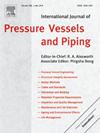Monotonic deformation behavior of SA333 Gr-6 steel: Dynamic strain aging
IF 3
2区 工程技术
Q2 ENGINEERING, MECHANICAL
International Journal of Pressure Vessels and Piping
Pub Date : 2025-03-21
DOI:10.1016/j.ijpvp.2025.105511
引用次数: 0
Abstract
The present investigation intends to examine how the dynamic strain aging (DSA) phenomenon affects tensile flow curves, mechanical properties, and dislocation density through tensile loading. Monotonic tensile tests were carried out at room temperature (RT) and elevated temperatures up to 400 °C, whereas the strain rate varied from 1 × 10−4 s−1 to 1 × 10−2 s−1. Several features of DSA include serrations on the stress-strain curve, negative strain rate sensitivity, an increase in ultimate tensile strength, and a decrease in ductility with an increase in the temperature of the tensile test. DSA phenomenon was quite evident in a temperature range of 200–350 °C at all the strain rates; nevertheless, the dominant DSA temperature regime was observed between 250 and 300 °C for a slow strain rate of 1 × 10−4 s−1. However, an increase in the strain rate, the dominant DSA was observed at increased test temperature. Transmission electron micrographs taken post-tensile test revealed that the test conditions that showed a dominant DSA behavior have a higher dislocation density as compared to conditions where there was insignificant or no DSA. The dominant DSA and non-DSA tensile tested specimens had dislocation densities of 12 × 1015 m−2 and 5 × 1015 m−2, respectively. The shift of dominant DSA phenomena was explained with the help of dislocation waiting time at local barriers and diffusion time of solute atoms at the test temperature.

SA333 Gr-6钢的单调变形行为:动态应变时效
本研究旨在研究动态应变时效(DSA)现象如何通过拉伸加载影响拉伸流动曲线、力学性能和位错密度。在室温(RT)和高达400°C的高温下进行单调拉伸试验,应变速率从1 × 10−4 s−1到1 × 10−2 s−1。DSA的几个特征包括应力-应变曲线上的锯齿,负应变率敏感性,极限抗拉强度增加,塑性随拉伸试验温度的升高而降低。在200 ~ 350℃温度范围内,各应变速率下均存在明显的DSA现象;然而,在250 ~ 300°C之间观察到主要的DSA温度状态,应变速率为1 × 10−4 s−1。然而,随着应变速率的增加,DSA在测试温度的升高中占主导地位。拉伸后拍摄的透射电子显微照片显示,与不存在DSA或不存在DSA的条件相比,DSA占主导地位的测试条件具有更高的位错密度。DSA和非DSA拉伸试样的位错密度分别为12 × 1015 m−2和5 × 1015 m−2。利用位错在局域势垒处的等待时间和溶质原子在测试温度下的扩散时间解释了DSA优势现象的转移。
本文章由计算机程序翻译,如有差异,请以英文原文为准。
求助全文
约1分钟内获得全文
求助全文
来源期刊
CiteScore
5.30
自引率
13.30%
发文量
208
审稿时长
17 months
期刊介绍:
Pressure vessel engineering technology is of importance in many branches of industry. This journal publishes the latest research results and related information on all its associated aspects, with particular emphasis on the structural integrity assessment, maintenance and life extension of pressurised process engineering plants.
The anticipated coverage of the International Journal of Pressure Vessels and Piping ranges from simple mass-produced pressure vessels to large custom-built vessels and tanks. Pressure vessels technology is a developing field, and contributions on the following topics will therefore be welcome:
• Pressure vessel engineering
• Structural integrity assessment
• Design methods
• Codes and standards
• Fabrication and welding
• Materials properties requirements
• Inspection and quality management
• Maintenance and life extension
• Ageing and environmental effects
• Life management
Of particular importance are papers covering aspects of significant practical application which could lead to major improvements in economy, reliability and useful life. While most accepted papers represent the results of original applied research, critical reviews of topical interest by world-leading experts will also appear from time to time.
International Journal of Pressure Vessels and Piping is indispensable reading for engineering professionals involved in the energy, petrochemicals, process plant, transport, aerospace and related industries; for manufacturers of pressure vessels and ancillary equipment; and for academics pursuing research in these areas.

 求助内容:
求助内容: 应助结果提醒方式:
应助结果提醒方式:


